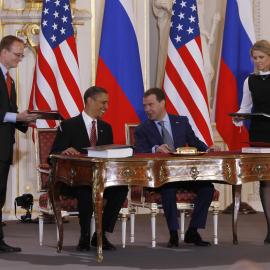Gideon Rose (“What Obama Gets Right,” September/October 2015) gives U.S. President Barack Obama generally high marks for his handling of foreign policy, but among his criticisms, Rose claims that Obama’s “initial flirtation with leftist pieties about nuclear disarmament predictably came to nothing.” This is a caricature of the Obama administration’s nuclear policies and represents a failure to recognize the place of nuclear disarmament in the international order Rose correctly praises Obama for trying to bolster.
As a candidate for president in 2008, Obama embraced the nuclear policy framework outlined in January 2007 by former Secretary of State Henry Kissinger, former Chair of the Senate Armed Services Committee Sam Nunn, former Secretary of Defense William Perry, and former Secretary of State George Shultz—a foursome not generally thought of as leftist or given to pieties. Noting that the world was on the precipice of a new and dangerous nuclear era and that reliance on nuclear weapons for deterrence was becoming increasingly dangerous and decreasingly effective, they called for a global effort to pursue practical steps toward a world free of nuclear weapons, “a bold initiative consistent with America’s moral heritage.”
Backed by this strong nonpartisan consensus—supported by two-thirds of former U.S. secretaries of state and defense and national security advisers, plus a chorus of their peers from around the world—Obama followed through on his campaign commitment once elected and made nuclear weapons the subject of a major foreign policy address in Prague in 2009, where he expressed “America’s commitment to seek the peace and security of a world without nuclear weapons.”
To say that Obama’s policies have come to nothing is unfair. The 2010 New START agreement between the United States and Russia will produce modest and verifiable reductions in strategic arms, and the nuclear security summits have been an innovative approach to securing nuclear materials around the globe. Moreover, the Iran nuclear deal is an accomplishment directly tied to the president’s Prague agenda.
It is true, however, that the Obama administration has not matched its words with deeds. After securing ratification of New START in December 2010, the administration was not ready with a plan for pushing the president’s new nuclear agenda. It was not until June 2013, in Berlin, when the president outlined his nuclear policy goals for his second term, including further reductions in deployed strategic nuclear weapons by up to one-third, “bold” reductions in tactical nuclear weapons in Europe, and a fourth nuclear security summit in 2016. Nine months later, Russia seized Crimea, seemingly shutting the door to further progress for the time being.
The reason for this disconnect has been the administration’s inability to make difficult choices. The United States has not moved from a nuclear triad (nuclear-capable strategic bombers, land-based intercontinental ballistic missiles, and submarine-launched ballistic missiles) to a nuclear dyad, leaving the next administration with an unaffordable nuclear modernization program that would undermine conventional capabilities. Nor has it removed nuclear weapons from “prompt-launch status” to reduce the risk of an accidental or mistaken firing of a nuclear ballistic missile. And it has not thought seriously about how to strengthen NATO’s overall defense posture absent basing U.S. nuclear weapons in Europe at great expense and risk. All these steps could and should have been taken by the current administration—and still could and should be taken by its successor.
STEVE ANDREASEN
Lecturer, Hubert H. Humphrey School of Public Affairs, University of Minnesota
